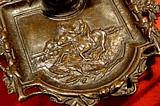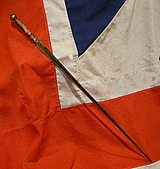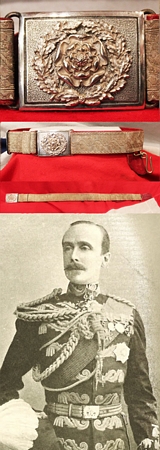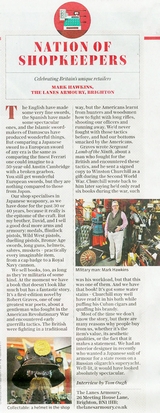Antique Arms & Militaria
A Super, Antique Bronze Equestrian ' Horse Racing' Collectable
Ideal for the gentleman or lady with a passion for horse racing, horses or equine collectibles. In fine cast bronze, in the form of chamber stick. With a finely detailed relief design of a horse race, showing two race horses side by side with jockeys. With a mount for a matchbox, and a rear finger loop for holding and carrying. read more
275.00 GBP
An 18th Long, Boot or Cloak Sword
Cast brass hilt with relief figural decoration, and hawthorn wood grip. Steel rapier blade with engraving and deep fuller. Circa 1750. The knuckle bow and guard have been purposefully removed and the hilt re-attached. We had one quite similar, around 20 years ago, which came with an old article from a Connoisseur journal, It described, what was called, a boot or cloak sword. In the days of the threat by highwaymen, when a gentleman may have the need to consistently travel from town to town on horseback, but not by mail coach, a constant traveler might adapt a sword that could be easily slotted into knee high riding boots, or slipped into an especially constructed sleeve inside a riding cloak. For in wet and inclement weather a gentleman's flintlock pistol could not function, so without a sword for protection he was dangerously defenseless. Naturally a standard rapier short sword would be more normal, but on occasion, a gentleman that traveled constantly, or journeyed on perilous pursuits [such as a revenue man] might require a more concealable sword that would be far more easily manageable on both horseback or on foot. It also has the unique advantage of being eminently useable as a short distance spear type weapon, as it's weight balance is now very effective for that alternate purpose. 29.75 inches long overall read more
295.00 GBP
A Superb English Lord-Lieutenant's Silver Belt and Silver Lace Bullion Belt
Victorian. The silver buckle bears a centrally mounted English rose motif with an oakleaf and acorn wreath surrounding. A red Morocco leather lined belt which is covered in pure silver silver lace brocade bullion, in the continued design of the highest rank oak leaf and acorn scrolling vine, representing the monarch's personal representative, the Lord Lieutenant.
The Lord-Lieutenant is the British monarch's personal representative in each county of the United Kingdom. Historically, the Lord-Lieutenant was responsible for organising the county's militia. Lieutenants were first appointed to a number of English counties by King Henry VIII in the 1540s, when the military functions of the sheriff were handed over to him. He raised and was responsible for the efficiency of the local militia units of the county, and afterwards of the yeomanry, and volunteers. He was commander of these forces, whose officers he appointed. These commissions were originally of temporary duration, and only when the situation required the local militia to be specially supervised and well prepared; often where invasion by Scotland or France might be expected.
Lieutenancies soon became more organised, probably in the reign of his successor King Edward VI, their establishment being approved by the English parliament in 1550. However, it was not until the threat of invasion by the forces of Spain in 1585 that lieutenants were appointed to all counties and counties corporate and became in effect permanent. Although some counties were left without lieutenants during the 1590s, following the defeat of the Spanish Armada, the office continued to exist, and was retained by King James I even after the end of the Anglo-Spanish War.
The office was abolished under the Commonwealth, but was re-established following the Restoration under the City of London Militia Act 1662, which declared that:
The King's most Excellent Majesty, his Heirs and Successors, shall and may from Time to Time, as Occasion shall require, issue forth several Commissions of Lieutenancy to such Persons as his Majesty, his Heirs and Successors, shall think fit to be his Majesty's Lieutenants for the several and respective Counties, Cities and Places of England and Dominion of Wales, and Town of Berwick upon Tweed.
Although not explicitly stated, from that date lieutenants were appointed to "counties at large", with their jurisdiction including the counties corporate within the parent county. For example, lieutenants of Devon in the seventeenth and eighteenth centuries appointed deputy lieutenants to the City of Exeter, and were sometimes described as the "Lieutenant of Devon and Exeter" The origin of this anomaly may have lain in the former palatine status of Pembrokeshire.
The City of London was uniquely given a commission of lieutenancy, and was exempt from the authority of the lieutenant of Middlesex. The Constable of the Tower of London and the Warden of the Cinque Ports were ex-officio lieutenants for the Tower Hamlets and Cinque Ports respectively, which were treated as counties in legislation regarding lieutenancy and militia affairs.
The official title of the office at this time was His or Her Majesty's "Lieutenant for the county of ..", but as almost all office-holders were Peers of the realm, they were referred to as "Lord-Lieutenant". read more
385.00 GBP
A Feature on The Lanes Armoury in the London Daily Telegraph
Celebrating Britain's Unique Retailers; A most kind review of Mark Hawkins and The Lanes Armoury by Tom Ough of the Daily Telegraph. See a scan of the article, as it appeared in the Daily Telegraph, in the gallery. This other review was completed earlier this year; Mark Hawkins celebrates 50 th year at The Lanes Armoury this year [2021].The story so far of the Hawkins Brothers and "The Lanes Armoury" written and updated by Frank Taylor; Sadly it is likely the last, true, original 'armoury' shop left in the whole of Britain. They were described as one of the most highly recommended visitors attractions in the whole of the UK by the New York Times. It is also regularly featured by many other world wide publications, appearing in too many television programmes to list, including Italian and Japanese documentaries, plus the Discovery Channels "Mud Men", and Ian McShane's world famous tv series, "Lovejoy". Several film locations have been filmed in their shops, including Graham Greene's " Brighton Rock", and Roger Moore's film series "The Persuaders", way back in 1971. Hundreds of thousands of tourists [and regular visitors] come to see them every single year, including in the 1970's President Ronald Reagan, and in October 1970 Elizabeth Taylor with Richard Burton also visited [and it was during that extraodinary visit Elizabeth Taylor sold to Camilla, {Mark and David's mother}, her bespoke diamond and ruby encrusted Rolex watch]. Also in the 1960's Edward G. Robinson visited, and H.M. Queen Elizabeth and HRH Prince Philip came through the Lanes, and their store in the 1980's, as did the HRH the Aga Khan. The 'Hawkins brothers' evolved their company from one of the oldest established family businesses in Sussex, with a client base that includes museums, heads of state, presidents, princes and kings. But whether you are a movie star, a head of state or a student, all will be treated with the same courtesy and respect. Every sale is important to them, albeit a £5 badge, a £500 sword, a £50,000 medieval book, or maybe a Gothic suit of armour for £40,000. Every day they are told that to some, this is their favourite shop in the world, with some foreign visitors returning year in year out for 40 years or even more, so they truly believe they have a great responsibility to their customers, their reputation, and to the amazing city of Brighton. Their oldest customer has incredibly been a regular buyer, for an amazing, over 75 years. The partners, Mark and David regularly appear on the BBC and numerous UK TV channels on various antique 'discovery' programs, and act as consultant appraisers. During Mark's 48 years, and David's 36 years [that's over 80 years combined] with the family business, it is estimated they have had pass through their hands, and appraised, possibly more items than any other living dealers in the country, and their breadth of knowledge and experience is simply astonishing. While in his capacity as export director of the old family company Mark was personally responsible for the sale and export of over 2,000 individual antiques, armouryantiques and militaria items every single week for nearly ten years. Shipping their treasures to the four corners of globe. Of course, these days [and for the past 30 years] the brothers are concentrating their attention to being England's leading specialist arms and militaria dealers, limiting their business to fine, ancient, antique or vintage samurai weaponry, armour, militaria and historical books, covering the past three millennia. It is now said they are the largest samurai weapon dealers in the western world, and this website is the largest of it's type in the world including over 17,0000 full colour photographs of some of their items for sale.
With so many different histories to offer, you can feel freer in Brighton than in most British cities to select trips which coincide with your interests and of course, you're much more likely to find in Brighton things to do which bring the history you love to life. For the lover of militaria, a visit to The Lanes Armoury is a must with a difference. The Armoury's housed in a three-storey 16th century building and is a real treasure trove, it's a museum which is not a museum as everything is for sale. It has been nominated and then short-listed for the British Antique & Collectors Awards as the best Antique Shop in Great Britain and is the latest incarnation of a much older business David Hawkins [Brighton] Ltd which was one of the earliest and largest dealers in Antiques and Collectibles within the whole of Europe in the last century. It's their current specialisation in Arms, Armour, Militaria, and Books which really marks them out and creates such a fascinating and fantastic place to visit. From bronze-age swords, axes and daggers, suits of samurai and European armour, muskets, revolvers, duelling pistols, American civil war swords, right through to medals and World War II militaria, it's all there to be viewed and drooled over. For example, they have in stock at present a 19th century 'Vampyre Killing Kit', [near identical to one in the Tower Collection] essential for those Victorian trips to the Carpathian mountains and Transylvania, and last year had a signed 1st Edition book that once personally belonged to Winston Churchill detailing a story of combat in the American Revolutionary War. It was presented to him during WW2 and signed by it's author, Robert Graves, one of England's greatest WW1 poets and novelists. It was declared by Churchill, in a personal letter to Robert Graves thanking him for the gift, that it was one of only 6 or 7 novels that he had read during his premiership in the war, and subsequently this very book was used by him to advise the creation and modus operandi of the new British Commandos. They have two pages in a folio from one of the earliest printed books, and a Ist Ed, book of 1479 By Bartolomaeus Platina, and just recently in, an Autographed copy of Christmas Carol by Charles Dickens at just under £25,000 [now sold]. It's not a museum, although often believed to be, and when you leave, you've really have had the same experience! I can honestly say the experience of a visit to the armoury, although not a vast premises by any means, in fact probably the smallest recommended by the New York Times, but is utterly memorable, and every single person that passed through their doors while I was there was either astonished, amazed, or both! But remember, although it looks and feels like a museum, as the brothers reminded me, everything is for sale!.... read more
Price
on
Request
Antique Brass Pressure/Steam Gauge From The World's Oldest Aquarium
A piece of Victorian public attraction history. We are fortunate to acquire a few old Victorian steam gauges, due to the refit of the world's oldest working aquarium in Brighton, now called the Sea Life Centre, and the largest in Britain. The main aquarium hall was some 70 metres long, a feat of Victorian engineering that housed a Victorian tea room and wondrous exhibits. First unveiled in 1872, the Aquarium was designed by Eugenius Birch, the man behind Brighton?s West Pier, at a cost of ?130,000. One exhibit was a recreation of Captain Nemo's Nautilus, the legendary submarine, these gauges were part of the display, that has now been removed due to the restoration programme. One hundred years ago the Brighton Aquarium was acclaimed as being the largest and most imaginative Aquarium in the world. People came from far and wide to see the new sea world. The idea to build the greatest Aquarium in the world came from a London architect and designer of marine piers, Eusebuis Birch. Brighton, on the south coast, with splendid hotels and a new railway link to London, seemed the ideal choice. A site facing the West Pier, which he had already designed, was the first choice but the ultimate decision was for a building at the west end of a new road now known as Madeira Drive, where once stood a toll house for the famous Chain Pier. Before any work could commence it was essential to obtain permission from the local authorities and from Parliament. The first of several Acts of Parliament for the project received the Royal Assent on July 12th 1869 and work start immediately. The estimate for the building involved a sum of ?100,000, further increased to ?133,000 the following year. Because buildings were not allowed to rise above the Marine Parade, a great deal of excavating was carried out. Facing stones used in the protecting sea wall came chiefly from blocks that made up the original Blackfriars Bridge, London.
The courtyard had five terra-cotta arches supported by pillars enriched with carvings of mermaids, sea nymphs and other marine symbols. In the large entrance hall and lining the 224ft. long corridor, were the fish tanks in archways leading up to a vaulted ceiling, supported by columns of polished red Edinburgh granite, and green serpentine marble, with pillars of Bath stone and a mosaic flooring. The somewhat subdued light coming from inside the tanks, controlled to suit the environment of the marine life inside, gave an impression of mystery and excitement, almost as though one was deep under the sea, looking into the strange world of fishes.
The wide corridor led to a conservatory which had an attractive grotto complete with a cascade of water. Later this became a popular meeting place. Although the building was far from ready, it was decided to open on Easter Saturday 1872. with the idea that the official opening would take place during August, when the premises would have been completed. Queen Victoria's third son. Prince Arthur, arrived that Easter, in Brighton, with Prince Edward of Saxe-Weimar. The Royal Party expressed a wish to see the new Aquarium and it was necessary to carry out immediate work on the roadway in order that the Royal Party and their ladies could enter the Aquarium without sinking up to their ankles in mud. With flags flying, the Princes enjoyed their visit. Pausing "ever and anon" to view the interesting specimens. The Press described this impromptu opening as "very propitious" and "It could scarcely have entered the minds of any of the most sanguine of the Aquarium directors that its opening would be attended by a Prince of the Blood Royal. On August 10th 1872 the Mayor, Sir Cody Burrows, declared the premises open, despite great problems with contractors, a difficult site, the sea and the weather, plus many battles with Parliament and Brighton Council. The Aquarium Clock Tower became famous all over the world and picture postcards
of its familiar facade sold in their thousands. read more
110.00 GBP
" Loot the Lanes" https://pierpressure.co.uk/ The Best Escape Room in UK
An interactive game for all the family based around our shop, voted the best in the UK. For Visitors to Brighton That Enjoy Interactive Games for 'All The Family', Try Pier Pressure Escape Rooms at 33 Upper North St, Brighton BN1 3FG. They have an Internationally renown "Escape Room", it was voted 64th best in the world, out of 82,865 interactive escape rooms worldwide, and the very best one in the UK. The Escape Room is Titled "Loot The Lanes" and it is based around a recreation of our shop, The Lanes Armoury. Loot the Lanes, which pays homage to several of the city?s landmarks, is a fast-paced interactive game in which players go on a mission to steal legendary treasure to stop it falling into the wrong hands.
In the story the "Brighthelm Diamond" is a secret jewel which has been purchased and hidden by four of Brighton?s most influential developers, in case the city was ever in dire need.
Players must solve puzzles and work their way through a series of clues in a mock-up set of The Lanes, which includes a red telephone box and The Lanes Armoury antique weaponry shop, before breaking into an antique jewellers to find the diamond.. Links to it are here, just copy and paste; https://pierpressure.co.uk/escaperooms/loot-the-lanes/ https://www.theargus.co.uk/news/18283688.brightons-loot-lanes-escape-room-ranks-best-uk/ read more
Price
on
Request
Amazing Facts You Might Not Know
Did you know the date that the last woman was lawfully executed by 'burning at the stake' was in Britain?. Believe it or not, it was Catherine Murphy, in only in 1788, just over a mere 230 years ago. Interestingly, only women warranted to be burnt at the stake, men were just hanged. Women were sentenced to be burnt at the stake for just two reasons only, 'Petty Treason', [the murder of a spouse] and 'High Treason' [interfering with the Crown's Coinage, known as coining, either by counterfiting, or chipping, cutting and the filing off of coins edges]. read more
Price
on
Request
A Very Good Sykes Patent Disc Form Powder Flask
A most unusual shape of powder flask that due to a flat form would fit snugly in an overcoat pocket rather well. Good spring. 6.75 inches long x 4 inches wide x 1.5 inches deep at its widest read more
155.00 GBP
A Good Original 48 Bore 19th Century Pistol Ball Scissor Mould
Maker stamped I W, bore size stamped 48 read more
100.00 GBP
A George IIIrd Campaign Sheffield Plate Candelabra of Col. 10th Hussars
We acquired this stunning campaign, Sheffield silver plated candelabra, with his yataghan sword, used by a former Colonel of the 10th Hussars throughout his campaigning years in the army. The yataghan in these photographs we sold earlier, but we do have his other scabbarded yataghan. The Sheffield plating has wear on all the dominant edges and this is referred to as 'copper bleeding'. It is actually a traditional and good sign of originality for true Sheffield plate, as it shows it is early Sheffield hammered onto a copper base, not the later modern electrotype of plate, usually on nickel or brass. The use of "Sheffield plate" began in 1742 when Thomas Boulsover, a Sheffield cutler (blade smith), discovered that a sheet of silver fused to a piece of copper could then be rolled or hammered out without fracturing the bond.
This made possible the use of "plated" base metal, which appeared, outwardly, to be silver, but as the silver "skin" could be only a small proportion of the gauge of the metal the saving in expense was considerable and objects made from the product looked exactly like sterling silver, because the applied 'plate' was indeed sterling. Boulsover's idea was exploited in Sheffield, first by Joseph Hancock from 1755 onwards and Matthew Boulton, one of the greatest and successful manufacturers of his age. This candelabra from the early 1800's and the reign of King George IIIrd was used by Capt. Wood during his campaigns in the Victorian period. It disassembles into several smaller pieces and would likely have fitted into a wooden, leather bound travelling case for use in military campaigns around the Empire. It was used originally by his ancestor in the Napoleonic wars era. His medals were sold in auction some 17 years ago. Manners Charles Wood was born on 20 January 1852. He was appointed as Ensign to the 44th Foot on 1 September 1869, but was transferred on the same day to the 66th Foot, becoming Lieutenant in October 1871. He transferred to the 10th Hussars on 15 April 1874, and joined the regiment in India. In 1876 he was selected for escort duty with the Prince of Wales during his visit to India, and was given a silver commemorative medal struck on that occasion.
Promoted to Captain on 2 February 1878, Manners Wood accompanied the regiment from Rawal Pindi in the Afghan campaign of 1878-79, and commanded ?B? Troop at Fattehabad on the 2nd April 1879, in which action he was wounded, and his life saved by a brother officer, in an incident reported on the front page of the Illustrated London News, published on 17 May 1879.
?Captain Wood and Lieutenant Fisher dismounted with most of the men, leaving as few as possible to hold the horses and advanced up the hill in skirmishing order, to dislodge the enemy, who were firing upon them from their strong position. On approaching the top, Captain Wood and Lieutenant Fisher, who were well in front, noticed a Ghazi, lying on the ground, pointing his jezail at them. He was a typical hillman, of powerful build. Having fired and missed, he jumped to his feet, and rushed at Captain Wood, whose sword was of little use against the long jezail and impetuous rush of the Afghan. He was brought to his knees, and his fanatical assailant, discarding his firearm, with a ponderous knife made a cut at his head, which clove his helmet in two, but, fortunately, did not do more than inflict a slight wound.
?As Captain Wood lay on the ground, at the mercy of the Afghan, Lieutenant Fisher rushed at the Ghazi, and felled him with the butt end of a carbine which he was carrying and Private Hackett, who had by this time come up with other men of the Troop, gave him the coup-de-grace with his sword. The Troop now fired two volleys into the enemy, which completely dispersed them, and Captain Wood took his men back to Fattehabad. The casualties in the Troop were seven men wounded, one horse killed, eleven wounded, and one missing.?
Captain Wood served with the regiment throughout the remainder of the war, and accompanied it during the march of pestilence to Rawal Pindi, when so many Tenth Hussars died of cholera. He became Major in April 1882, and Lieutenant-Colonel in August 1892, on taking command of the 10th Hussars. The regiment served in Ireland throughout the 4 years of his command. He became Brevet Colonel in August 1896, and retired on 5 April 1899.
Wood was almost immediately recalled on the outbreak of the war in South Africa, and was appointed a Special Service Officer with the Rhodesian Field Force. He was afterwards in command of the troops in Rhodesia, from 7th January to 21st June 1901, graded as a Colonel on the Staff. He again left the Army, leading a very active life, and later became a Colonel in the Army Cadet Force. For his services with the Cadets, he received the 1935 Silver Jubilee medal, at the age of 83. Colonel Manners Wood died at Camberley on 12 September 1941, aged 89. read more
985.00 GBP











